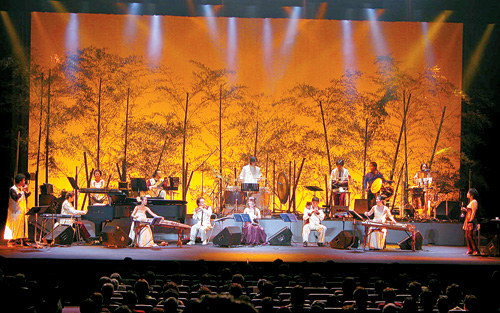A modern take on Korean tradition heats up an Osaka stage

Seulgidoeng, a group that fuses modern and Korean traditional music, at the Osaka International House. [JoongAng Ilbo]
Formed in 1985 with the aim of popularizing gugak, the group has won numerous awards including the KBS music award for best gugak group in 1995, The Korean National Assembly’s culture award and the culture award of the year from the Arts Council Korea in 2004. Their hits, such as “Sandokkaebi,” are even in some elementary music text books. Former members include Choi Yun-sang of the percussion group Gongmyeong; composer Won Il; gayageum (a twelve-stringed Korean harp) player and professor at The Korean National University of Arts, Min Ui-sik; and Korean flute player and professor at Chugye University for the Arts, Gang Ho-jung.
The performance was Seulgidoeng’s most recent visit to the city after they appeared at the NHK Hall in Osaka in 2005. Lead by Lee Jun-ho (a senior conductor for the KBS Traditional Music Orchestra) who plays sogeum, a small Korean flute, Seulgidoeng added to the “Korean wave” in Japan.
It was four years ago that Seulgidoeng had its first encounter with Japan. Goh Jeong-ja, 59, a children’s author who operates a Korean barbecue restaurant in the Ikuno district, was walking past a record store on a visit to Seoul when he heard Seulgidoeng’s music. After a few inquiries, he contacted Mr. Lee and persuaded him to write the music for a musical Mr. Goh was working on, “The Song of Bean Sprouts.” The story is about an old Korean-American woman who reminisces about her life in Korea while dedicating herself to taking care of her children. “Although I also listen to traditional Korean music, Seulgidoeng’s music, which mixes exciting rhythms and a modern approach to the traditional, is popular with third-generation Korean-Americans,” said Mr. Goh.
This performance at Osaka International House also grew out of an invitation from Mr. Goh’s company, Bean Sprout Management.
During the first half of the performance, the group showcased traditional Korean music including pansori, or traditional narrative songs, like “Heungboga” and “Dontaryeong.”
The second half featured fusion gugak, using synthesizers, piano, bass, Korean bamboo flute, gayageum, janggu (an hourglass-shaped Korean drum) and more. During the traditional narrative song “Chunhyangga,” the narration in some parts took a form similar to rap music set to a jazzy rhythm. Min Yeong-chi, a janggu player and former member of Seulgidoeng who is now the leader of a percussion group called Santa, joined his former group and raised the performance’s intensity level even more.
Other people who performed include composer/pianist Hong Dong-gi; gayageum player Jung Gil-sun, from a gugak group in Gyeonggi province; Han Chung-eun, a senior Korean bamboo flute player at KBS Traditional Music Orchestra; Kim Gyeong-a, a senior Korean piccolo player at KBS Traditional Music Orchestra; and Kim Ji-hee, a member of the folk music division at The National Center for Korean Traditional Performing Arts.
By Lee Jang-jik JoongAng Ilbo [jainnie@joongang.co.kr]










with the Korea JoongAng Daily
To write comments, please log in to one of the accounts.
Standards Board Policy (0/250자)